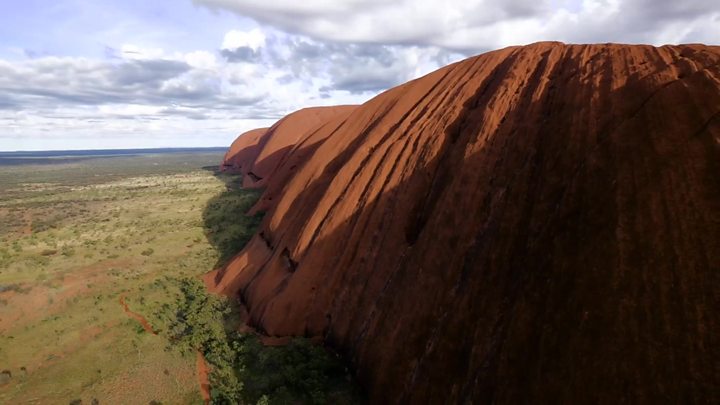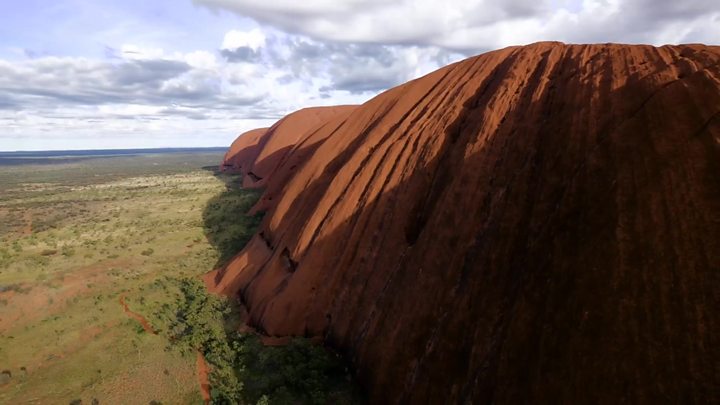Uluru climbing ban: Tourists scale sacred rock for final time
Huge crowds scaled the rock on the last day before a ban to respect Aboriginal wishes begins. …


Media playback is unsupported on your device
Huge crowds scrambled up Australia’s Uluru for the final time on Friday, ahead of a ban on climbing the sacred rock.
The giant monolith – once better known to visitors as Ayers Rock – will be permanently off limits from Saturday.
Uluru is sacred to its indigenous custodians, the Anangu people, who have long implored tourists not to climb.
Only 16% of visitors went up in 2017 – when the ban was announced – but the climb has been packed in recent weeks.
The final climbers faced a delayed start due to dangerously strong winds – one of many reasons Uluru has been closed to people wishing to reach the top over the years.
The walk can be hazardous, with dozens dying since the 1950s. The high temperatures in the area, which can reach 47C (116F) in the summer, mean visitors have died of dehydration and other heat-related events.
But the steep and slippery climb to the summit – which stands 348m (1,142ft) high – can also prove dangerous. Just last year, a Japanese tourist died while attempting to ascend one of the steepest parts of the rock.
Yet after park officials deemed the climb safe to open, hundreds of people made the trek up on Friday.
Photos of people in lines snaking up Uluru in past months have even drawn comparisons to recent scenes on Mount Everest.
One social media user posted a timelapse showing the massive queue at Uluru on Thursday.
The entrance gate was due to be closed at 16:00 local time (06:30 GMT) on Friday. Once people come down, officials said a metal chain used as a climbing aid would be immediately dismantled.
Why is the climb being closed?
In 2017, the board of the Uluru-Kata Tjuta National Park voted unanimously to end the climb because of the spiritual significance of the site, as well as for safety and environmental reasons.
One Anangu man told the BBC that Uluru was a “very sacred place, [it’s] like our church”.
“People right around the world… they just come and climb it. They’ve got no respect,” said Rameth Thomas.
There are several signs at the base of Uluru that urge tourists not to climb because of the site’s sacred value.
“It’s difficult to see what that significance is,” one man who climbed this week told the BBC. “It’s a rock. It’s supposed to be climbed.”
‘Time to rest and heal’
Phil Mercer, BBC News at Uluru-Kata Tjuta National Park
There was joy when signs that had asked visitors not to walk up Uluru were removed by park rangers at the base of the big red rock.
A long fight by traditional owners to stop visitors scaling its summit was finally over. An Aboriginal elder said it was time to let this most sacred of places “rest and heal”.
There were jeers from a small group of Indigenous women. “Get off the rock,” they shouted as two men from Germany – a father and son – made their way down.
When the final group of climbers descended for the last time with the heat of the unrelenting afternoon sun on their faces, they spoke of their exhilaration at climbing one of Australia’s most recognisable places. A visitor from Sydney said that on top it was like being on another planet, while a mum from Darwin told me she hoped that one day the ban would be overturned.
Nearby campgrounds and hotels were fully booked this week. This had led to tourists camping illegally and dumping waste, locals said.
The climb’s closure is not expected to significantly affect visitor rates to the national park, officials and tourism operators say.
What are Uluru’s sacred stories?
The Anangu believe that in the beginning, the world was unformed and featureless. Ancestral beings emerged from this void and travelled across the land, creating all living species and forms.
Uluru is the physical evidence of the feats performed by ancestral beings during this creation time.
One such story is that of Lungkata, a greedy and dishonest blue-tongue lizard, who came to Uluru from the north and stole meat from Emu. When Emu followed him back to his cave, Lungkata ignored him.
“He went back to sleep, pretending he was asleep,” one of Uluru’s indigenous custodians, Pamela Taylor, told the BBC last year. “Emu got very angry and made a fire and it went right up into the cave and the smoke blocked him and he fell down.”
Ms Taylor pointed to a huge blue patch high on Uluru, saying it was where Lungkata’s burnt body rolled down and left a mark.
“He did bad things by going around stealing. That’s why we tell the children not to go around stealing things, because they will get punishment like Lungkata.”
She added some stories were too sacred to tell.
Read more: ‘This rock means everything to us’




